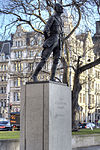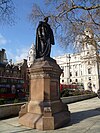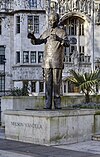Parliament Square

Parliament Square is a square at the northwest end of the Palace of Westminster in the City of Westminster in central London, England. Laid out in the 19th century, it features a large open green area in the centre with trees to its west, and it contains twelve statues of statesmen and other notable individuals.
As well as being one of London's main tourist attractions, it is also the place where many demonstrations and protests have been held. The square is overlooked by various official buildings: legislature to the east (in the Houses of Parliament), governmental executive offices to the north (on Whitehall), the judiciary to the west (the Supreme Court), and the church to the south (with Westminster Abbey).
Parliament Square features all of the British flags, the flags of the United Kingdom, its four countries,[1] the county flags[1] and the three flags of the Crown Dependencies and the sixteen heraldic shields of the British Overseas Territories.[2]
Location
[edit]Buildings looking upon the square include the churches Westminster Abbey and St Margaret's, Westminster, the Middlesex Guildhall which is the seat of the Supreme Court of the United Kingdom, Government Offices Great George Street serving HM Treasury and HM Revenue and Customs, and Portcullis House.
Roads that branch off the Parliament Square are St Margaret Street (towards Millbank), Broad Sanctuary (towards Victoria Street), Great George Street (towards Birdcage Walk), Parliament Street (leading into Whitehall) and Bridge Street (leading onto Westminster Bridge).
History
[edit]

Original layout
[edit]Parliament Square was laid out in 1868 in order to open up the space around the Palace of Westminster and improve traffic flow, and featured London's first traffic signals. A substantial amount of property had to be cleared from the site. The architect responsible was Sir Charles Barry. Its original features included the Buxton Memorial Fountain, which was removed in 1949 and placed in its present position in nearby Victoria Tower Gardens in 1957.
In 1949, the design for the replanning of the Parliament Square area, Westminster, London was carried out by the architect, George Grey Wornum (1888–1957)[3]
Post Second World War changes
[edit]The plans to redesign the Square predated the Second World War as the Ministry of Transport suggested:
that a larger central island was necessary to allow traffic more room in Great George Street. If the northern side of the central island were lengthened it was expected that the frequent traffic blocks at the junction of Parliament Street and Bridge Street with Parliament Square would be greatly reduced.[4]
| Parliament Square (Improvements) Act 1949 | |
|---|---|
| Act of Parliament | |
 | |
| Long title | An Act to authorise certain improvements in and around Parliament Square, and for purposes connected therewith. |
| Citation | 12, 13 & 14 Geo. 6. c. lvi |
| Dates | |
| Royal assent | 16 December 1949 |
| Text of statute as originally enacted | |
Following the war, London County Council submitted a revised plan that was agreed by the Ministry of Transport and legislated for by Parliament with the Parliament Square (Improvements) Act 1949.The Act was required due to the mixed ownership of the land. The redesign included putting new roads, pavement and gardens in the area.
As St George Street[Great George Street?] was widened and an existing road was moved, the Buxton Memorial Fountain had to be removed. Because Victorian style architecture was unpopular at the time, some in Parliament argued it should never be re-erected: at least one parliamentarian said it had "no artistic merit whatever"[5] The Act provided that the fountain could be removed, but required its re-erection.
The central garden of the square was transferred from the Parliamentary Estate to the control of the Greater London Authority by the Greater London Authority Act 1999. It has responsibility to light, cleanse, water, pave, and repair the garden, and has powers to make bylaws for the garden.
Public demonstrations
[edit]The east side of the square, lying opposite one of the main entrances to the Palace of Westminster, has historically been a common site of protest against government action or inaction. On May Day 2000 the square was transformed into a giant allotment by a Reclaim the Streets guerrilla gardening action. Most recently, Brian Haw staged a continual protest there for several years, campaigning against British and American action in Iraq. Starting on 2 June 2001, Haw left his post only once, on 10 May 2004 – and then because he had been arrested on the charge of failing to leave the area during a security alert – and returned the following day when he was released. The alleged disruption caused by Haw's protest led Parliament to insert a clause into the Serious Organised Crime and Police Act 2005 making it illegal to protest in Parliament Square (or, indeed, in a large area reaching roughly half a mile in all directions) without first seeking[obtaining?] the permission of the Metropolitan Police Commissioner.
The provisions of that Act relating to Parliament Square were repealed by the Police Reform and Social Responsibility Act 2011, which provides for a different regime of "prohibited activities".[6]
As well as sparking a great deal of protest from various groups on the grounds of infringement of civil liberties including the European Convention on Human Rights, the Act[2005 or 2011?] was initially unsuccessful in accomplishing its goals: Brian Haw was held to be exempt from needing authorisation in a High Court ruling, as his protest had started before the Act came into effect (though any new protests would be covered); Haw remained in Parliament Square. Later, the Court of Appeal overturned this ruling, forcing Haw to apply for police authorisation to continue his protest.
Statues
[edit]The square is home to twelve statues of British, Commonwealth, and Anglosphere political figures. They are listed here in anti-clockwise order, beginning with Winston Churchill's statue, which faces Parliament.
| Image | Subject | Location | Sculptor | Date of unveiling | Notes | Listing |
|---|---|---|---|---|---|---|

|
Winston Churchill Prime Minister 1940–1945 and 1951–1955 |
North-eastern edge of the green |
Ivor Roberts-Jones | 1 November 1973 |
Unveiled by Clementine, Baroness Spencer-Churchill. Churchill indicated his desire for a statue of himself in this spot when Parliament Square was redeveloped in the 1950s.[7] Roberts-Jones's initial versions of the statue were felt to bear too close a resemblance to Benito Mussolini.[8] |
Grade II |

|
David Lloyd George Prime Minister 1916–1922 |
Northern edge of the green | Glynn Williams | 25 November 2007 |
Unveiled by the Prince of Wales and Duchess of Cornwall. Stands on a plinth of slate from Penrhyn Quarry, North Wales.[9] |
—
|

|
Jan Smuts Prime Minister of South Africa 1919–1924 and 1939–1948 |
Northern edge of the green |
Sir Jacob Epstein | 7 November 1956 |
Winston Churchill, on his return to power in 1951, wished to erect a statue to Smuts; he was, however, unable to perform the unveiling due to illness. The pedestal is of granite from South Africa.[10] |
Grade II |

|
Henry John Temple, 3rd Viscount Palmerston Prime Minister 1855–1858 and 1859–1865 |
North-western edge of the green |
Thomas Woolner | 2 February 1876 |
Palmerston is portrayed in middle age, before he became prime minister. The pedestal departs from the "Gothic" model of the nearby statues of Derby and Peel.[11] |
Grade II |

|
Edward Smith-Stanley, 14th Earl of Derby Prime Minister 1852, 1858–1859 and 1866–1868 |
North-western edge of the green |
Matthew Noble | 11 July 1874 |
Derby is represented wearing his robes as Chancellor of Oxford University. The bronze reliefs around the pedestal depicting scenes from his life were executed by Noble's assistant, Horace Montford.[12] |
Grade II |

|
Benjamin Disraeli, 1st Earl of Beaconsfield Prime Minister 1868 and 1874–1880 |
Western edge of the green |
Mario Raggi | 19 April 1883 |
The statue was the "shrine" of the Primrose League, a conservative association established in Disraeli's memory, who left wreaths in front of it every year on "Primrose Day", the anniversary of his death.[13] |
Grade II |

|
Sir Robert Peel Prime Minister 1834–1835 and 1841–1846 |
Western edge of the green |
Matthew Noble | 1877 |
Initially a statue of Peel was commissioned from Carlo Marochetti. This was ready by 1853 but was considered to be far too large. Marochetti produced a smaller work which was placed at the entrance to New Palace Yard; this was removed in 1868 and melted down in 1874.[14] |
Grade II |

|
George Canning Foreign Secretary 1807–1809 and 1822–1827; Prime Minister 1827 |
At the square's junction with Great George Street |
Sir Richard Westmacott | 2 May 1832 |
Originally erected in New Palace Yard; in its current location since 1949. The features are based on the portrait bust of Canning by Sir Francis Chantrey, who was "not at all pleased with the preference shewn to Mr. Westmacott".[15] |
Grade II |

|
Abraham Lincoln President of the United States 1861–1865 |
In front of the Middlesex Guildhall |
Augustus Saint-Gaudens | July 1920 |
A recasting of the statue in Lincoln Park, Chicago. This statue was unveiled by Prince Arthur, Duke of Connaught, after being ceremonially presented by the American ambassador and accepted by Prime Minister David Lloyd George. Initially the statue was to be erected in 1914, but this was postponed. By that time some favoured an alternative statue by George Grey Barnard, which was eventually erected in Manchester.[16] |
Grade II |

|
Nelson Mandela President of South Africa 1994–1999 |
South-western edge of the green |
Ian Walters | 29 August 2007 |
Westminster Council had earlier refused permission for placing the statue in Trafalgar Square adjacent to South Africa House.[17] The statue was unveiled by Prime Minister Gordon Brown in the presence of Wendy Woods, the widow of Donald Woods, a late anti-apartheid campaigner, and the British actor, director and long-time friend of Woods, Richard Attenborough. |
—
|

|
Mahatma Gandhi Indian Independence Leader |
Western edge of the green |
Philip Jackson | 14 March 2015 |
The statue of the Indian independence movement leader Mahatma Gandhi is based on a photograph of Gandhi standing outside the offices of Prime Minister of the United Kingdom Ramsay MacDonald in 1931.[18] It was unveiled by Indian Finance Minister Arun Jaitley on 14 March 2015. The statue was dedicated as a commemoration of the centennial of Gandhi's return to India from South Africa, which is generally regarded as the commencement of his efforts for Indian independence. Speakers at the unveiling of the statue included Prime Minister of the United Kingdom David Cameron, Indian film star Amitabh Bachchan and Gandhi's grandson Gopalkrishna Gandhi.[18] |
—
|

|
Millicent Fawcett Campaigner for women's suffrage |
North-western edge of the green |
Gillian Wearing | 24 April 2018 |
Erected in conjunction with the centenary of women being granted the vote in the UK, following a campaign led by Caroline Criado-Perez, this is the first statue of a woman to be included in Parliament Square.[19] It is by Gillian Wearing, making her the first woman to create a statue that stands in Parliament Square. Dame Millicent was a prominent leader during the campaign for women's suffrage, serving as president of the National Union of Women's Suffrage Societies for more than twenty years, as well as co-founding Newnham College, Cambridge. This statue depicts her as a 50-year-old, the age at which she became president of the National Union of Women's Suffrage Societies. The banner her statue holds reads: "Courage Calls to Courage Everywhere", an extract from a speech she made after the death of suffragette Emily Wilding Davison. |
—
|
Demonstrations
[edit]The Parliament Square Peace Campaign was a peace campaign started by Brian Haw in 2001 and carried on by Barbara Tucker until 2013.[20][21]
In May 2010, a peace camp known as Democracy Village was set up on the square to protest (initially) against the British government's involvement in invasions in the Middle East, which became an eclectic movement encompassing left-wing causes and anti-globalisation protests.
The Mayor of London Boris Johnson appealed to the courts to have them removed and, after demonstrators lost an appeal in July 2010, Lord Neuberger ruled that the protesters camping on the square should be evicted.[22] The final tents were removed in January 2012.[23]
Panorama
[edit]References
[edit]- Citations
- ^ a b "Historic county flags raised in day of national celebration". Gov.uk. Gov.uk. 23 July 2021. Retrieved 13 July 2024.
- ^ "Overseas Territories flags flown for the first time in Parliament Square". Gov UK. Gov UK. 31 October 2012. Retrieved 13 July 2024.
- ^ "Design for the replanning of the Parliament Square area, Westminster, London". RIBApix.
- ^ "Parliament Square (Improvements) Bill Debate". Hansard Parliament. 23 November 1949.
- ^ "Parliament Square (Improvements) Bill". Hansard UK Parliament. 23 November 1949.
- ^ The law and history on protest around Parliament, including the ban that was enforced under SOCPA and the narrower restrictions under the Police Reform and Social Responsibility Act 2011 are analysed in an article on protest in Parliament Square. Kiron Reid 'Letting Down the Drawbridge: Restoration of the Right to Protest at Parliament'. (2013) 1 Law Crime and History 16 (pp. 16–51) (Internet (free access)). ISSN 2045-9238. [1] The file is a pdf.
- ^ Howard, Philip (2 November 1973). "Resolute and defiant as ever, Churchill's statue is revealed". The Times.
- ^ "Winston Churchill's statue 'had a look of Mussolini'". The Daily Telegraph. London. 1 January 2004. Retrieved 23 September 2011.
- ^ "Lloyd George statue 'is a disgrace'". The Independent. 26 October 2007. Archived from the original on 25 May 2022. Retrieved 30 September 2011.
- ^ Ward-Jackson 2011, pp. 206–10
- ^ Ward-Jackson 2011, pp. 195–97
- ^ Ward-Jackson 2011, p. 192
- ^ Ward-Jackson 2011, pp. 200–03
- ^ "Noble, Matthew (bap. 1817, d. 1876), sculptor". Your Archives. The National Archives. Retrieved 23 October 2011.
- ^ Ward-Jackson 2011, pp. 190–92
- ^ "The statue of Abraham Lincoln in Parliament Square". Your Archives. The National Archives. Archived from the original on 12 June 2011. Retrieved 7 October 2011.
- ^ "London Mandela statue for Parliament Sq". BBC News. 29 August 2007. Retrieved 30 September 2011.
- ^ a b James Dunn (14 March 2015). "Gandhi statue unveiled in Parliament Square – next to his old enemy Churchill". The Independent. Archived from the original on 25 May 2022. Retrieved 4 May 2017.
- ^ "Millicent Fawcett: Statue of suffragist unveiled". BBC News. 24 April 2018.
- ^ "Parliament Square peace campaigner Brian Haw dies". BBC. 19 June 2011. Retrieved 19 June 2011.
- ^ Peace at last! Final anti-war protesters leave Parliament Square after 12 years 9 May 2013 standard.co.uk
- ^ "Parliament Square protesters lose eviction appeal – BBC News". BBC. 16 July 2010. Retrieved 4 May 2017.
- ^ "Parliament protest camp removed". BBC News. 17 January 2012. Retrieved 3 December 2018.
- Bibliography
- Ward-Jackson, Philip (2011). Public Sculpture of Historic Westminster: Volume 1. Public Sculpture of Britain. Liverpool: Liverpool University Press.
Further reading
[edit]- Simon Bradley and Nikolaus Pevsner, The Buildings of England, London 6: Westminster (2003). ISBN 0-300-09595-3.


